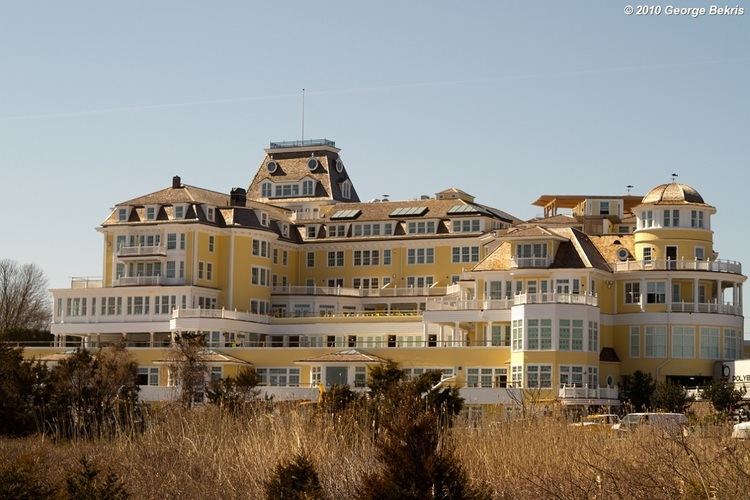 | ||
Address 1 Bluff AvenueWatch Hill, RI 02891 Floor area 152,165 square feet (14,136.6 m) Architect Centerbrook Architects and Planners(2010 Redevelopment) Developer Charles M. Royce(2010 Redevelopment) | ||
Ocean House is a large, Victorian-style waterfront hotel originally constructed in 1868 on Bluff Avenue in the Watch Hill historic district of Westerly, Rhode Island.
Contents
The original 1868 hotel closed in 2003, was demolished in 2005 and a new facility in heavily revised form opened in 2010 on the same site, retaining much of the original structure's form as well as the original name. Both the original and its reconstruction are noted for a their rambling Victorian architecture and distinctive yellow siding.
At the time of its closing, the original Ocean House was the last waterfront Victorian Era hotel on mainland Rhode Island.
History
Originally built in 1868 the Ocean House was smaller compared to the other hotels located on Watch Hill, and over the years the hotel expanded with numerous additions. The original Ocean House was a central structure in the Watch Hill Historic District, which is listed on the National Register of Historic Places.
In March, 2004, Girouard Associates of New Canaan, Connecticut purchased the facility from heirs of the Louis D. Miller family, which had owned the hotel since 1938. Girouard Associates intended to raze Ocean House and build five large oceanfront homes. A protest ensued, a new buyer was ultimately found, and the spirit of the original building — if not the actual building in its entirety — was preserved.
In 1916, a motion picture starring Douglas Fairbanks called American Aristocracy was filmed at the Ocean House.
Closing, protest and demolition
Factors related to the closing of the original Ocean House included its lack modern amenities, its dilapidated condition, and its non-compliance with current building codes.
The original Ocean House operated seasonally, open roughly three months a year, and the building lacked a heating, air conditioning, and ventilation system. In the last years of its operation, the top two floors were unused and of its original 159 rooms, only 59 were serviceable. The aging facility lacked requisite amenities, service functions, egress requirements, handicapped accessibility requirements and parking. Prior to its closing "grand staircases led nowhere. Rainwater sept through the walls and runs down wired-in-place gutters. The oak elevator was broken."
Notably, the 138-year-old building was non-compliant with current building and life safety codes. The building's timber structure had been compromised by indiscriminate installation of electric, gas and plumbing utilities — as well as a subsequent reconfiguration of rooms to include private bathrooms. After the 2003 Great White Station nightclub fire, Rhode Island's fire codes were both revised and more rigorously enforced, rendering the deficiencies at Ocean House insurmountable. In 2004, the hotel was not permitted to open because of code deficiences.
Compliance with current life-safety standards, including those for hurricane and wind protection, would require installation of interior structural shear walls; new hurricane-rated windows with new frames; a new concrete foundation with steel tie-downs throughout; stripping of all interior and exterior lead paint; and removal of interior mold — the latter requiring demolition of interior finishes.
The original Ocean House ceased operations in 2003 and was sold. When the community learned in March 2004 that an developer from out-of-town would raze Ocean House and build five homes in its place, organizers — including representatives from Preserve Rhode Island, Rhode Island Historical Preservation and Heritage Commission as well as the National Trust — began a campaign to save the building and preserve the site's public oceanfront access and beach. Another buyer was found, who deemed requirements to make the building functional and code compliant both economically and physically unfeasible — but promised to rebuild it from the ground up. The original building was demolished and a new facility constructed on site.
Reconstruction
Project architects met resistance with the demolition of Ocean House, but successfully argued for reconstruction, suggesting a building modeled after the building at the zenith of its history, circa 1908, would allow for a 49-room hotel appropriate in scale for its adjacent streets, while expanding toward the beach where 23 condominiums could be accommodated — along with the amenities and service functions that could make the project functionally and economically feasibile.
The original Ocean House structure was demolished in December 2005 and the subsequent facility opened in 2010.
The new design, at 156,000 sf (50,000 sf larger than the original), reconstructs much of the original massing; restores certain original details that had been removed during the ongoing operation of the original facility (e.g., the original mansard roof); and incorporates new elements, notably subterranean facilities as well as two new wings extending from the main building — that also shield neighboring residential areas from hotel activities.
The original facility was documented, overall dimensions and heights were preserved, including the size and location of windows. Actual pieces of the original building were salvaged and the design replicates columns, capitals, and woodwork. Materials within human reach are wood while detailing out of reach is more easy to maintain synthetic materials.
The new facility features 49 guest rooms and 23 residential condominium suites as well as meeting rooms, spa, lap pool, fitness center, and restaurant. The design also accommodates service functions requisite to a modern facility: up to date kitchens, loading docks, mechanical rooms, fire egress requirements (e.g., redundant stairs), and staff facilities.
